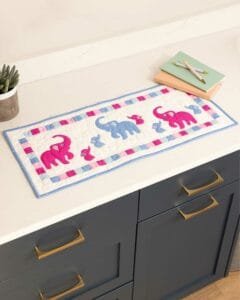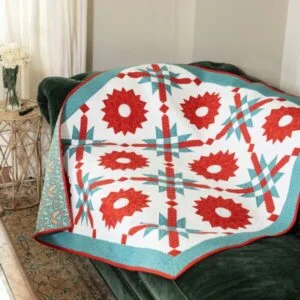The Windmill Block – Tutorial is a fantastic way to introduce dynamic movement into your quilting projects. This block pattern is characterized by its rotating design, which resembles the blades of a windmill.
It’s a versatile block that can be adapted to many quilting styles, from traditional to modern, making it a favorite among quilters of all skill levels. Whether you are new to quilting or have years of experience, this Windmill Block – Tutorial will guide you through the process of creating this eye-catching block.
The Windmill Block is not only visually appealing but also relatively simple to construct. Its geometric design is created by combining triangles and squares, giving the illusion of motion, which makes it an excellent choice for larger quilts, table runners, or even wall hangings.

In this tutorial, we’ll break down the steps involved in creating the Windmill Block, from selecting fabrics to assembling the block, ensuring that you have all the tools and knowledge you need to succeed.
By the end of this tutorial, you’ll have a solid understanding of how to make a Windmill Block, and you’ll be able to incorporate this stylish design into your quilting projects. Plus, we’ll cover some frequently asked questions to help address any concerns you may have before starting. Let’s dive in!
1. Choosing Fabrics for Your Windmill Block
Selecting the right fabric for your Windmill Block is the first crucial step in ensuring the success of your project. The contrast between fabrics is essential for creating the sharp, rotating effect that defines the Windmill Block – Tutorial.
1.1 High Contrast for Bold Designs
The Windmill Block works best when there is a high contrast between the two main fabrics. Consider using light and dark fabrics together to emphasize the windmill pattern. For instance, pairing a white or cream fabric with a dark navy or black will create a striking look.
1.2 Choosing Color Schemes
When selecting fabrics, think about the color scheme of your overall quilt. The Windmill Block can fit into both traditional and modern quilts depending on your fabric choices. For a more traditional look, earth tones or primary colors work well, while pastels and bright, bold colors lend a modern flair.
1.3 Using Patterned Fabrics
Don’t be afraid to incorporate patterned fabrics into your Windmill Block. Small-scale prints can add texture without overwhelming the design. If using patterned fabric, consider keeping one of the fabrics solid to maintain clarity in the block’s shape.
1.4 Pre-washing Your Fabrics
Pre-washing your fabric is always recommended to avoid shrinkage or color bleeding. Especially if you’re working with high-contrast fabrics, pre-washing will ensure that the darker fabrics don’t bleed onto the lighter ones.
1.5 Fabric Weight Considerations
Stick with medium-weight quilting cottons for the Windmill Block to ensure consistency and durability. Avoid very heavy or stretchy fabrics, as they may distort the shape of the block during assembly.
1.6 Scrap-Friendly Option
The Windmill Block is also a great scrap-busting project. If you have leftover fabric from previous projects, this block allows you to mix and match small pieces, creating a unique and personalized quilt.
2. Cutting and Preparing the Fabric Pieces
Once you’ve chosen your fabrics, the next step in the Windmill Block – Tutorial is cutting and preparing the fabric pieces. Precision is key here to ensure that your block comes together smoothly.
2.1 Essential Tools for Cutting
To cut your fabric accurately, you’ll need a rotary cutter, cutting mat, and quilting ruler. These tools will help you make precise cuts and ensure that all your fabric pieces are the correct size.
2.2 Measuring and Cutting the Squares
For a standard Windmill Block, you’ll need four equal-sized squares from each of the two contrasting fabrics. The size of your squares will determine the overall size of your block, but a common size is 5-inch squares for a 9-inch finished block.
2.3 Creating Half-Square Triangles
The Windmill Block is constructed using half-square triangles. To create these, take one square of each fabric and place them right sides together. Draw a diagonal line from corner to corner on the lighter fabric, and sew a quarter-inch seam on either side of the line.
2.4 Cutting the Triangles
Once you’ve sewn the squares, cut along the diagonal line. This will give you two half-square triangles. Repeat this process for the remaining squares until you have four half-square triangles in total.
2.5 Trimming the Triangles
After sewing and cutting your triangles, trim the edges to ensure they are the exact size needed for your block. Using a square quilting ruler makes this step easier and helps maintain accuracy.
2.6 Pressing the Seams
Press the seams of your half-square triangles open or to one side. Pressing them open helps reduce bulk, while pressing them to the darker side prevents the seam from showing through the lighter fabric.
3. Assembling the Windmill Block
Now that your fabric pieces are prepared, it’s time to assemble your Windmill Block. This part of the Windmill Block – Tutorial will walk you through the layout and construction of the block.
3.1 Laying Out the Pieces
Before sewing, lay out your four half-square triangles in a windmill pattern. The darker fabric triangles should create the illusion of rotating blades when placed correctly. Take your time arranging the pieces to ensure the pattern looks balanced.
3.2 Checking the Alignment
Once the pieces are laid out, double-check that the points align where the triangles meet in the center. Precise alignment is crucial for achieving a polished and professional-looking Windmill Block.
3.3 Sewing the Pairs Together
Begin by sewing two adjacent triangles together, forming two sets of pairs. Use a quarter-inch seam allowance for all seams. After sewing, press the seams open or to one side.
3.4 Joining the Pairs
Next, sew the two pairs together to complete the block. Be sure to pin at the intersection where the four triangles meet to ensure the points match perfectly.
3.5 Pressing the Block
After assembling the block, give it a final press. This will help flatten any bulky seams and give the block a crisp, finished appearance.
3.6 Trimming the Edges
If necessary, trim the edges of your block to ensure it is square. A quilting ruler helps ensure accuracy, and trimming makes it easier to join this block with others in a larger quilt.
4. Using Windmill Blocks in a Quilt
Now that you’ve mastered the Windmill Block, it’s time to think about how to incorporate it into a full quilt design. This section of the Windmill Block – Tutorial will provide tips on arranging your blocks and finishing your quilt.
4.1 Planning Your Quilt Layout
There are many ways to arrange Windmill Blocks in a quilt. You can place the blocks in rows for a traditional look, or you can rotate each block to create a more dynamic, swirling effect.
4.2 Adding Sashing Between Blocks
For a more structured quilt, consider adding sashing between your Windmill Blocks. Sashing helps define each block and can make the overall design less busy. Use a complementary color for the sashing to tie the quilt together.
4.3 Adding Borders
A border around your quilt adds a finishing touch and frames the Windmill Blocks. You can use a solid fabric for a clean look or a patterned fabric for added interest.
4.4 Quilting the Layers
Once your quilt top is complete, you’ll need to quilt the layers together. You can follow the lines of the Windmill Block for a clean, geometric look, or try free-motion quilting to add texture and depth to your design.
4.5 Binding the Quilt
After quilting, it’s time to bind the edges of your quilt. Choose a binding fabric that complements your quilt, and sew it around the edges to finish your project.
4.6 Displaying or Gifting Your Quilt
Once completed, your Windmill Block quilt is ready to be displayed in your home or given as a thoughtful, handmade gift. The dynamic design will impress anyone who sees it!
FAQ
Q: Is the Windmill Block suitable for beginners?
A: Yes, the Windmill Block – Tutorial is great for beginners. Its straightforward construction of half-square triangles makes it easy to follow, even for those new to quilting.
Q: What size should the Windmill Block be?
A: The size of the Windmill Block can vary depending on your project. A common finished block size is 9 inches, but you can scale the block up or down to suit your needs.
Q: How can I ensure my points align perfectly?
A: Precision in cutting and sewing is key to getting perfect points. Pinning at the intersections and sewing with a consistent seam allowance will help you achieve crisp points.
Q: Can I use patterned fabric for the Windmill Block?
A: Yes, patterned fabric can add depth to your Windmill Block. Just make sure the patterns aren’t too busy, as this can distract from the block’s design.
Q: How many Windmill Blocks do I need for a full quilt?
A: The number of blocks depends on the size of your quilt. For example, a lap quilt might require 20 blocks, while a bed quilt could need 40 or more.
Q: Can I hand-sew the Windmill Block?
A: Yes, you can hand-sew the Windmill Block if you prefer. However, machine sewing is faster and ensures more precise seams.
Join our VIP broadcast list and gain access to exclusive patterns, all for free. As a VIP member, you’ll receive the best patterns daily, delivered directly to your device. ✨📱 It’s a unique opportunity to stay up-to-date with the latest trends and designs, curated just for you. Don’t miss out on enhancing your projects and discovering new inspirations with the best patterns every day! 🎨🔝
Conclusion
In this Windmill Block – Tutorial, we’ve covered everything from selecting fabrics and cutting pieces to assembling the block and incorporating it into a quilt. The Windmill Block is a versatile and dynamic design that adds movement and interest to any quilt.
We hope this guide has inspired you to create your own Windmill Block quilt. Please share your thoughts, feedback, and suggestions in the comments below – we’d love to hear from you! Happy quilting!



